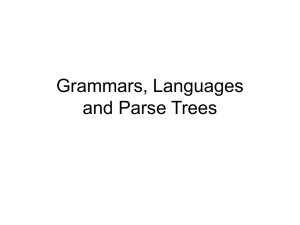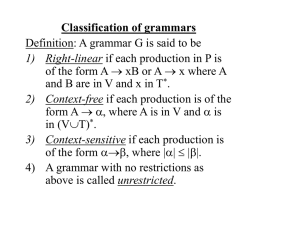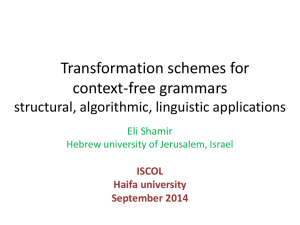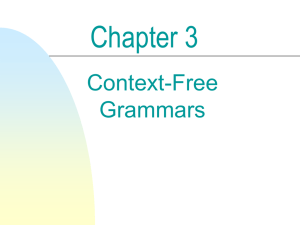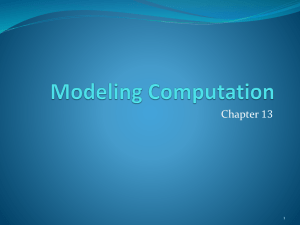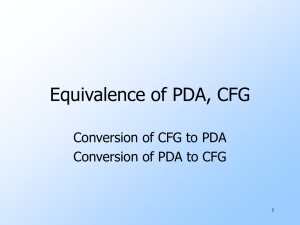Document
advertisement
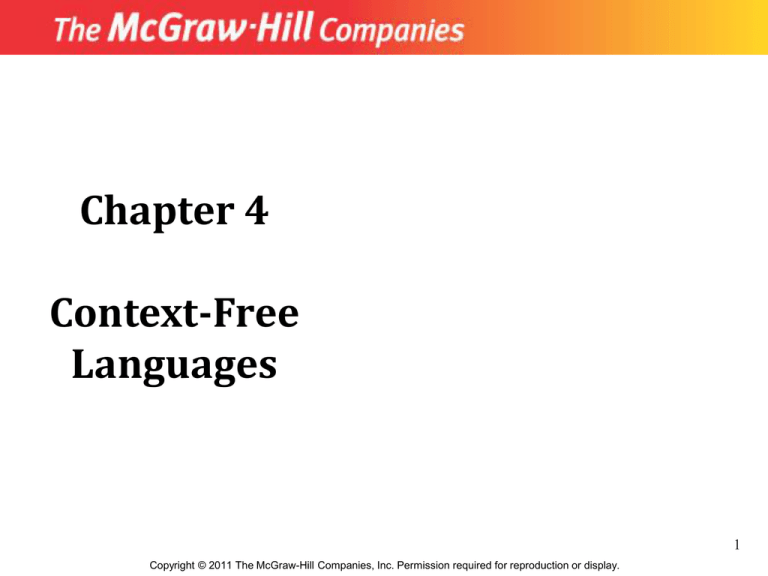
Chapter 4
Context-Free
Languages
1
Copyright © 2011 The McGraw-Hill Companies, Inc. Permission required for reproduction or display.
Using Grammar Rules to Define a
Language
• Regular languages and FAs are too simple for many
purposes
– Using context-free grammars allows us to describe
more interesting languages
– Much high-level programming language syntax can be
expressed with context-free grammars
– Context-free grammars with a very simple form
provide another way to describe the regular languages
• Grammars can be ambiguous
• We will study how derivations can be related to the
structure of the string being derived
Introduction to Computation
2
Using Grammar Rules to Define a
Language (cont’d.)
• A grammar is a set of rules, usually simpler than
those of English, by which strings in a language can
be generated
• Consider the language AnBn = {anbn | n 0}, defined
using the recursive definition:
– AnBn
– For every S AnBn, aSb AnBn
• Think of S as a variable representing an arbitrary
element, and write these rules as S S aSb
(In the process of obtaining an element of AnBn, S can be
replaced by either string)
Introduction to Computation
3
Using Grammar Rules to Define a
Language (cont’d.)
• If and are strings, and contains at least one
occurrence of S, then means that is obtained
from in one step, by using one of the two rules to
replace a single occurrence of S by either or aSb
• For example, we could write:
S aSb aaSbb aaaSbbb aaabbb
to describe a derivation of the string aaabbb
• We can simplify the rules by using the | symbol to
mean “or”, so that the rules become S | aSb
Introduction to Computation
4
Context-Free Grammars: Definitions
and More Examples
• Definition: A context-free grammar (CFG) is a 4-tuple
G=(V, , S, P), where V and are disjoint finite sets,
S V, and P is a finite set of formulas of the form
A , where A V and (V ∪ )*
– Elements of are terminal symbols, or terminals, and
elements of V are variables, or nonterminals
– S is the start variable, and elements of P are grammar
rules, or productions
– We use for productions in a grammar and for a
step in a derivation
– The notations n and * refer to n steps and
zero or more steps, respectively
Introduction to Computation
5
Context-Free Grammars: Definitions
and More Examples (cont’d.)
• We will sometimes write G to indicate a derivation
in a particular grammar G
• means that there are strings 1, 2, and in
(V ∪ )* and a production A in P such that
= 1A2 and = 12
– This is a single step in a derivation
• What makes the grammar context-free is that the
production above, with left side A, can be applied
wherever A occurs in the string (irrespective of the
context; i.e., regardless of what 1 and 2 are)
Introduction to Computation
6
Context-Free Grammars: Definitions
and More Examples (cont’d.)
• Definition: If G = (V, , S, P) is a CFG, the language
generated by G is
L(G) = { x * | S G* x}
(S is the start variable, and x is a string of terminals)
• A language L is a context-free language (CFL) if there
is a CFG G with L = L(G)
Introduction to Computation
7
Context-Free Grammars: Definitions
and More Examples (cont’d.)
• Consider AEqB = {x {a,b}* | na(x) = nb(x)}
• Let’s develop a CFG for AEqB
• If x is a non-null string in AEqB then either x = ay,
where y Lb = {z | nb(z) = na(z) + 1}, or x = by, where
y La = {z | na(z) = nb(z) + 1}
– We represent Lb by the variable B and La by the
variable A
– The productions so far are S | aB | bA
– All we need now are productions for A and B
Introduction to Computation
8
Context-Free Grammars: Definitions
and More Examples (cont’d.)
• If a string x La starts with a, then the remainder is a
member of AEqB
• If it starts with b, the rest has two more a’s than b’s
• Observation: a string containing two more a’s than
b’s must be the concatenation of two strings, each
with one more a; similarly with a and b reversed
• The grammar resulting from these observations is
S | aB | bA
A aS | bAA
B bS | aBB
(Note: if A were the start variable, it would generate La)
Introduction to Computation
9
Context-Free Grammars: Definitions
and More Examples (cont’d.)
• Theorem 4.9: If L1 and L2 are CFLs over , then so are
L1 ∪ L2, L1L2, and L1*
• Suppose G1 and G2 are CFGs that generate L1 and L2
respectively, and assume that they have no variables
in common
• Suppose that S1 and S2 are the start variables. Su, Sc
and Sk , the start variables of the new grammars, will
be new variables.
– Gu just adds the rules Su S1 | S2 to G1 and G2
– Gc just adds the rule Sc S1S2 to G1 and G2
– Gk just adds the rules Sk | SkS1 to G1
Introduction to Computation
10
Regular Languages and Regular
Grammars
• The three operations in Theorem 4.9 are the ones
involved in the recursive definition of regular
languages
• The “basic” regular languages over , and {}, are
easily seen to be CFLs
• Now we can prove by structural induction that every
regular language over is a CFL
• In fact, however, the CFG can be of a simpler form.
Definition 4.13: A context-free grammar is regular if
every production is of the form A B or A
Introduction to Computation
11
Regular Languages and Regular
Grammars (cont’d.)
• Theorem 4.14: For every language L *, L is regular
if and only if L = L(G) for some regular grammar G
• Proof:
– If L is a regular language, then there is a FA
M=(Q, , q0, A, ) that accepts it
– Define G=(V, , S, P) by letting V be Q, S the initial state
q0, and P the set containing the production T aU for
every transition (T, a) = U in M and the production
T for every accepting state T of M
Introduction to Computation
12
Regular Languages and Regular
Grammars (cont’d.)
• G is a regular grammar, and G accepts the same
language as M
– For every x = a1a2…an, the transitions on these symbols
that start at q0 end at an accepting state if and only if
there is a derivation of x in G
• To prove the other direction we can start with a
regular grammar G and reverse the construction to
produce M
– M may be an NFA, but it still accepts L(G), and it
follows that L(G) is regular
Introduction to Computation
13
Derivation Trees and Ambiguity
• So far we’ve been interested in what strings a CFG
generates
• It is also useful to consider how a string is generated
by a CFG
• A derivation may provide information about the
structure of a string, and if a string has several
possible derivations, one may be more appropriate
than another
• We can draw trees to represent derivations
Introduction to Computation
14
Derivation Trees and Ambiguity
(cont’d.)
• The root node represents the start variable S
• Any interior node and its children represent a
production A used in the derivation; the node
represents A, and the children, from left to right,
represent the symbols in .
• Each leaf node represents a symbol or
• The string derived is read off from left to right,
ignoring ’s
• Every derivation has exactly one derivation tree, but
a tree can represent more than one derivation
Introduction to Computation
15
Derivation Trees and Ambiguity
(cont’d.)
• In a derivation, at each step some production is
applied to some occurrence of a variable
• Consider a derivation that starts S S + S. We
could apply a production to either the first or second
of the S’s, but the resulting trees would be the same
• When we talk about a string having several possible
derivations, one being more appropriate, we are
talking about derivations corresponding to different
trees
Introduction to Computation
16
Derivation Trees and Ambiguity
(cont’d.)
• We can distinguish between trivially different
derivations and essentially different ones by
specifying that in a derivation, we always choose the
left-most variable to expand
• Definition 4.16: A derivation in a CFG is a leftmost
derivation (LMD) if, at each step, a production is
applied to the leftmost variable-occurrence in the
current string
– A rightmost derivation is defined similarly
Introduction to Computation
17
Derivation Trees and Ambiguity
(cont’d.)
• Theorem 4.17: If G is a CFG, then for any x L(G)
these three statements are equivalent:
– x has more than one derivation tree
– x has more than one LMD
– x has more than one RMD
• Proof: see book
• Definition 4.18: A CFG G is ambiguous if, for at least
one x L(G), x has more than one derivation tree (or
equivalently, according to Theorem 4.17, more than
one LMD)
Introduction to Computation
18
Derivation Trees and Ambiguity
(cont’d.)
• A classic example of ambiguity is the dangling else
• In C, an if-statement can be defined by
S if ( E ) S | if ( E ) S else S | OS
(where OS stands for “other statement”)
• Consider the statement
if (e1) if (e2) f(); else g();
– In C, the else to belong to the second if, but this
grammar does not rule out the other interpretation
• The two derivation trees shown on the next slide
show the two interpretations of a dangling else
Introduction to Computation
19
Introduction to Computation
20
Derivation Trees and Ambiguity
(cont’d.)
• Clearly the grammar given is ambiguous, but there
are equivalent grammars that allow only the correct
interpretation
• Example:
S S1 | S2
S1 if ( E ) S1 else S1 | OS
S2 if ( E ) S | if ( E ) S1 else S2
Introduction to Computation
21
Derivation Trees and Ambiguity
(cont’d.)
Consider the CFG G : S S + S | S * S | (S) | a
• G generates simple algebraic expressions
• One reason for ambiguity is that the relative
precedence of + and * hasn’t been specified: a+a*a
could be interpreted as (a+a)*a or as a+(a*a)
• In fact, S S + S causes ambiguity by itself, because
a+a+a could be interpreted as either (a+a)+a or
a+(a+a). Similarly for S S * S
• We might try to correct both problems by using the
productions S S + T | T T T + F | F
(think of T as “term” and F as “factor”)
Introduction to Computation
22
Derivation Trees and Ambiguity
(cont’d.)
• * now has higher precedence than + (all the
multiplications are performed within a term)
• By making the production S S + T, not S T + S,
we make + associate to the left. Similarly for *
• We want parenthetical expressions to be evaluated
first; this means we should consider such an
expression to be part of a factor. The resulting
unambiguous CFG generating L(G) is
S S + T | T T T * F | F F (S) | a
(proofs of unambiguity and equivalence are both
somewhat complicated)
Introduction to Computation
23
Simplified Forms and Normal Forms
• Questions about the strings generated by a CFG are
sometimes easier to answer if we know something
about the form of the productions
– For example, if we know that a grammar has no
-productions and no unit productions (A B) we
can deduce that no derivation of a string x can take
more than 2|x| - 1 steps (see book for details). We
could then, in principle, determine whether x can be
derived by considering derivations no longer than this
• We show how to modify an arbitrary CFG to have no
productions of either of these types
Introduction to Computation
24
Simplified Forms and Normal Forms
(cont’d.)
• Suppose we have the production A BCDCB, and
can be derived from either B or C. If we get rid of
-productions, then the steps that replace B and C by
will no longer be possible, but we must still be able
to get all the same non-null strings from A
• We must retain the production A BCDCB but we
should add A CDCB, A DCB, A BDCB, and so on
• We will need to know what variables can derive
(we will call such a variable a nullable variable)
Introduction to Computation
25
Simplified Forms and Normal Forms
(cont’d.)
• Definition 4.26: A recursive definition of the set of
nullable variables of G
– If there is a production A then A is nullable
– If A1, A2, …, Ak are nullable variables and there is a
production B A1A2… Ak , then B is nullable
• This leads immediately to an algorithm for
identifying the nullable variables
Introduction to Computation
26
Simplified Forms and Normal Forms
(cont’d.)
• Theorem 4.27: For every CFG G = (V, , S, P) the
following algorithm produces a CFG G1=(V, , S, P1)
having no -productions for which L(G1) = L(G) – {}
– Identify the nullable variables in V and initialize P1 to P
– For every production A in P, add to P1 every
production obtained by deleting from one or more
variable-occurrences involving a nullable variable
– Delete every -production from P1, as well as every
production of the form A A
Introduction to Computation
27
Simplified Forms and Normal Forms
(cont’d.)
• The procedure we use to eliminate unit productions
is similar
• We first identify pairs of variables (A, B) for which
A * B (in this case we call B A-derivable); then for
each such pair (A, B) and each nonunit production
B , we add the production A
• Such pairs can be found as follows:
– If A B is a production, then B is A-derivable
– If C is A-derivable and C B is a production, then B is
A-derivable
– No other variables are A-derivable
Introduction to Computation
28
Simplified Forms and Normal Forms
(cont’d.)
• Theorem 4.28: For every CFG G = (V, , S, P) without
-productions, the CFG G1=(V, , S, P1) produced by
the following algorithm generates the same language
as G and has no unit productions:
– Initialize P1 to P, and for each A V, identify the
A-derivable variables
– For every such pair A B and every nonunit
production B , add the production A to P1
– Delete all unit productions from P1
Introduction to Computation
29
Simplified Forms and Normal Forms
(cont’d.)
• Definition 4.29: A CFG is said to be in Chomsky
normal form if every production is of one of these two
types:
A BC (where B and C are variables)
A (where is a terminal)
• Theorem 4.30: For every context-free grammar G,
there is another CFG G1 in Chomsky normal form
such that L(G1) = L(G) – {}
• The algorithm on the next slide shows how to
generate G1
Introduction to Computation
30
Simplified Forms and Normal Forms
(cont’d.)
• The first step is to eliminate -productions and unit
productions
• The second step is to introduce for every terminal
symbol a new variable X and production X
• In every production, replace every terminal by its
new variable (except for the new productions above)
• Replace a production like A BACB by the
productions A BY1, Y1 AY2, Y2 CB, where Y1
and Y2 are new variables
• The resulting CFG is in Chomsky normal form
Introduction to Computation
31
